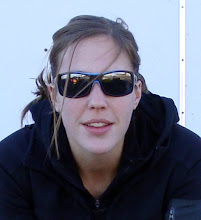 This is a photo of Eric at Westhaven earlier this year. Eric was involved in the Basler crash, and recently wrote an account of some of the events for a Dispatch article (only you Columbus-onians will know what that is.) I wanted to include part of Eric's account. Here it is, unabridged:
This is a photo of Eric at Westhaven earlier this year. Eric was involved in the Basler crash, and recently wrote an account of some of the events for a Dispatch article (only you Columbus-onians will know what that is.) I wanted to include part of Eric's account. Here it is, unabridged:The takeoff started normally. At Mount Paterson, as is typical at the places where we install our equipment, there is no runway. We land and takeoff in our ski-equipped airplane wherever the snow is adequately smooth that the pilot thinks those procedures can be done safely. Antarctic winds shape the snow into long ridges called "sastrugi". The pilot has to choose his takeoff and landing areas so as to avoid sastrugi large enough to damage the landing gear.
At Mt. Paterson, as our plane accelerated to takeoff speed, the bumps occurring as our skis crossed the sastrugi seemed to me at first to be nothing out of the ordinary. But as we continued to build speed and the bumps got harder, I braced my left arm against the seat in front of me so that I could be ready in case something happened. I estimate we were travelling close to 80 miles per hour when, after another hard bump, I saw the left wingtip hit the snow outside my window. Immediately the plane spun to the left and we went sliding. I put my right hand over my head to be ready to cushion my fall in case the plane were to flip over, but we came to a stop after just a few more seconds of sliding and bumping over the sastrugi.
My initial thoughts were I was glad that the plane had not flipped over, and I was relieved that I saw no fire. My next thoughts were that we should quickly disentangle ourselves from our collapsed seats and then get out in case a fire were to start.
After getting out of the plane, we called back to McMurdo on our satellite phone to explain our situation and to notify them that no one had been seriously hurt. At that point, we expected that it might be three or more hours before a plane could reach us, but we knew that since no one was badly injured, there was no need to risk an immediate rescue mission until all options had been considered as to the safest and most efficient way to get us out.
We were lucky that the weather was good, but we hoped that a plane would arrive before weather conditions deteriorated, since otherwise we might be stranded there for days. I think all of us are very aware of the dangers that our work entails, and we all work hard to minimize those risks. I think many of us have had "close calls" before during field work in remote areas, I know I have. The risks aren't unique to Antarctica. I love this work, and accidents like this are part of the territory. My main concern after the accident was that an airplane critical for our field work this year had now been wrecked. Without the DC-3, accomplishing this year's mission is going to be a lot more difficult.


1 Comments:
Hi Stefie Mike here
Read your blog.... Miss you sooooo much Great blog. Patty will be sending you e-mail soon-astill in bed!!!LOVE, Mike
4:59 AM
Post a Comment
<< Home